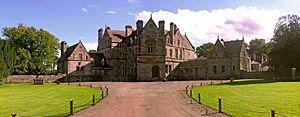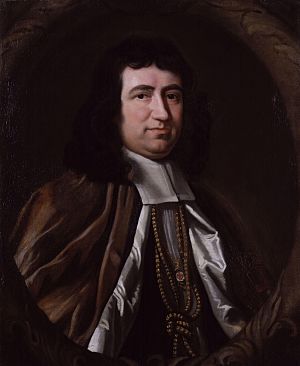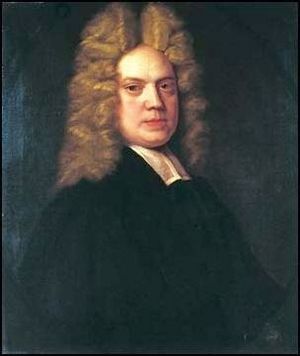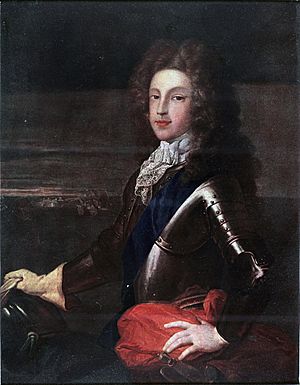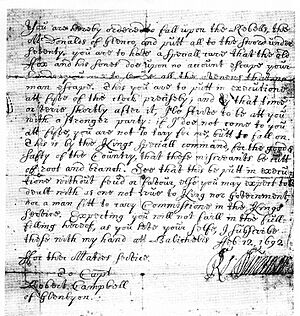Charles Leslie (nonjuror) facts for kids
Quick facts for kids Charles Leslie |
|
|---|---|
| Church | Church of Ireland |
| Orders | |
| Ordination | 1681 |
| Personal details | |
| Born | 27 July 1650 Dublin, Ireland |
| Died | April 13, 1722 (aged 71–72) Glaslough, County Monaghan, Ireland, |
| Buried | Glaslough |
| Alma mater | Trinity College, Dublin |
Charles Leslie (born July 27, 1650 – died April 13, 1722) was a priest from the Church of Ireland. He became a strong supporter of the Jacobite cause after the Glorious Revolution in 1688. Jacobites were people who believed that the Stuart family should still be kings and queens of England, Scotland, and Ireland.
Leslie was one of the few Irish Protestants who actively supported the Stuarts after 1688. He is remembered today for helping to make the 1692 Massacre of Glencoe widely known.
Contents
Who Was Charles Leslie?
Charles Leslie was born in Dublin, Ireland, on July 27, 1650. He was the sixth son of John Leslie and Katherine Conyngham. His father, John Leslie, was an important bishop in the Church of Ireland. He had served as a bishop in Scotland before moving to Ireland in 1633.
Charles was named after King Charles I, who was executed. He went to school in Enniskillen and then studied at Trinity College, Dublin.
After his father passed away in 1671, Charles first studied law in London. However, he later decided to become a priest. He was ordained as an Anglican priest in 1681. Soon after, he moved back to his family's estate at Glaslough in County Monaghan.
Charles Leslie married Jane Griffith. They had a daughter named Jane and two sons, Robert and Henry. Both of his sons also supported the Jacobite cause and lived in exile for a time. They later returned to Ireland.
Charles Leslie's Work
Charles Leslie became an assistant priest for the Church of Ireland parish of Donagh. However, most people in his parish were Roman Catholic or Presbyterian, so he did not have many duties.
His family had a strong connection to the Stuart kings. His father had been a chaplain to King Charles I. The family estate was even given to them by King Charles II as a reward for his father's service. Because of this, Charles Leslie strongly supported the Stuart family.
When the Catholic King James II became king in 1685, his brother-in-law, Henry Hyde, was made the King's representative in Ireland. Leslie's legal training led to Hyde appointing him as a church official and a local judge.
However, King James II's Catholic deputy began to remove laws that limited Catholics. Leslie used his writing skills to argue against appointing Catholics to public jobs. When King James II was removed from power in 1688 during the Glorious Revolution, Leslie was in England.
Becoming a Propagandist
After the Glorious Revolution, Leslie refused to promise loyalty to the new rulers, William III and Mary II. People who refused to take this oath were called "Non-Jurors." Because of this, Leslie lost his church positions.
He then became one of the most important writers and supporters of the Jacobite cause. He wrote many articles and pamphlets. One important person, Gilbert Burnet, called Leslie "the most violent Jacobite" in England at that time.
For the next twenty years, Leslie wrote many controversial papers. He wrote in favor of the Non-Juror cause. He also wrote against different religious groups and ideas, including Quakers, Jews, and Catholics.
The Glencoe Massacre Pamphlet
Much of Leslie's early writing focused on Scotland. In Scotland, the 1690 Settlement ended the rule of bishops in the church and brought back the Presbyterian church. Leslie used this to make people worried about William's plans for the Church of England.
Today, Leslie is best known for a pamphlet he wrote in 1695. It was called Gallienus Redivivus, or Murther will out, &c. This pamphlet focused on King William's supposed involvement in the death of a Dutch leader. It also included other accusations, like the Massacre of Glencoe. The Glencoe Massacre was a terrible event where many members of the MacDonald clan were killed by government soldiers.
Later Years and Exile
During the 1690s, Leslie acted as a messenger between James II's court, which was in exile in France, and the Non-Juror community in England.
In 1702, Queen Anne, the last Stuart monarch, came to the throne. This led to more Jacobite activity. In 1704, Leslie started a weekly newspaper called The Observator, which later became The Rehearsal. He used this paper to promote his Jacobite ideas.
However, his newspaper was forced to close in 1709. He also had disagreements with his former friends. In 1711, a warrant was issued for his arrest because of one of his writings. He escaped to Paris, France, where James Francis Edward (James II's son) was living.
Leslie continued to write and work as a Jacobite agent. After a failed Jacobite uprising in 1715, France stopped supporting the Stuarts. They were forced to leave France and eventually settled in Rome.
Even though the Jacobite cause faced many failures, Leslie remained dedicated to it. However, he had always been against Catholicism, which made living in Rome difficult since the Pope supported the Stuarts. He also hoped to convert James to the Anglican faith, but James remained a devout Catholic.
Leslie returned to Paris in 1717. In 1719, he published a large collection of his Theological Works. These works were praised for their clever arguments. By 1721, many important people had promised to support his work financially.
Finally, the Earl of Sunderland allowed Leslie to return home to Ireland. The condition was that he stop his political activities. Charles Leslie died at Glaslough on April 13, 1722.
Charles Leslie's Writings
Besides his Theological Works, Charles Leslie wrote over 81 other publications. This does not even count the 397 issues of his newspaper, The Rehearsal. His writings were a major challenge to the government that came to power after the Glorious Revolution.
He wrote about many different subjects. For example, he wrote a detailed criticism of Paradise Lost, a famous poem by John Milton.
Some of Leslie's ideas were used by later writers in the 18th century. In the early 1800s, his Theological Works were reprinted. Even famous writers like John Henry Newman referred to them.
Some critics, like Samuel Johnson and Thomas Babington Macaulay, thought his writing style was more memorable than his actual ideas. Modern experts believe he was defending political ideas that were not very realistic.
Leslie's writings about Scotland had a lasting impact. The Glencoe Massacre was largely forgotten until 1859. Then, Thomas Babington Macaulay wrote about it in his History of England. Macaulay wanted to clear King William's name from all of Leslie's accusations, including the Massacre. However, by writing about it, Macaulay actually made the Massacre more widely known.
It is also argued that Leslie's views still influence how people see King William's reign. Many believe it was a difficult time for Scotland, with events like the Glencoe Massacre, the Darien scheme (a failed Scottish colony), and the 1707 Union (which joined Scotland and England).


